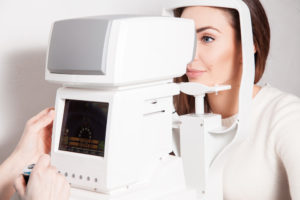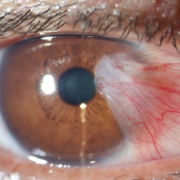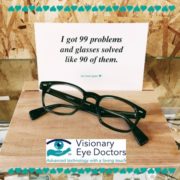Visionary Eye Doctors Newsletter – April 2018
In This Issue:
- 2 Reasons Eye Exams Are Important
- Relief for Symptoms of Dry Eye
- Spring Promotions – Sunglasses and BOTOX®
2 Reasons Eye Exams Are Important
 People often take their vision for granted, especially if they don’t need to wear corrective lenses. Even those who are nearsighted, farsighted, or have astigmatism might become complacent about eye exams if their vision is stable.
People often take their vision for granted, especially if they don’t need to wear corrective lenses. Even those who are nearsighted, farsighted, or have astigmatism might become complacent about eye exams if their vision is stable.
Regular eye exams are just as important as regular doctor visits. Here are 2 reasons why:
1. Identify Silent, Sight-Robbing Conditions
Eye exams can detect vision problems that you may be completely unaware of and allow for the earliest treatment possible, which may just save your sight!
One of our wonderful optometrists, Dr. Lorena Riveros, recently had a couple of patients that reported prior to their vision exams, their eyes and vision felt okay. However, during their exam, Dr. Riveros discovered large retinal holes that could have resulted in retinal detachment. Unfortunately, retinal holes are asymptomatic and fortunately, thanks to their eye exam with Dr. Riveros, they were able to get treatment and potentially save their eye sight!
Regular eye exams can provide early detection of eye issues and gives you the opportunity to consider a wider range of treatment options.
2. Alert You to Potentially Serious Health Problems
Your eye doctor can also identify underlying health problems just by looking at your eye health. In some cases, conditions like high blood pressure, diabetes, cancer and other medical conditions can be identified during regular eye exams.
Adult Eye Exam Recommendations
- Adults, ages 18 to 60: A comprehensive eye exam every 1 to 2 years
- Ages 61 and above: Annual comprehensive exams
At risk adults should have more frequent exams. Risk factors include:
- Family history of eye disease (glaucoma, macular degeneration, keratoconous)
- Diabetes or high blood pressure
- A visually demanding occupation or one that may pose a hazard to your eyes
- Taking prescription or OTC drugs that may have eye-related side effects
- Previous eye injuries or eye surgery
- Contact Lens wearers – Annual eye exams
If you have any family history of eye disease or vision problems, you should schedule eye exams more frequently.
Think about it, when was the last time you had an eye exam? Don’t put it off another year. Schedule your eye exam with us today!
Relief for Symptoms of Dry Eye
 Dry eye symptoms are the worst! Itching, watering, redness, sensitivity…It’s bad enough when these symptoms appear during allergy season. But when you have chronic symptoms that don’t go away, it might be time to seek professional relief.
Dry eye symptoms are the worst! Itching, watering, redness, sensitivity…It’s bad enough when these symptoms appear during allergy season. But when you have chronic symptoms that don’t go away, it might be time to seek professional relief.
Not all dry eye is the same therefore, not all dry eye treatment is the same. There are two basic types of dry eye:
1. Evaporative Dry Eye –
This is caused by blockage to the glands in the eyelid (the Meibomian glands) which leads to a shortage of oil on the surface of the tears and quicker than normal tear evaporation. This type of dry eye accounts for most of all dry eye cases.
2. Aqueous Dry Eye –
This occurs when the lacrimal glands do not produce enough tears.
As a Dry Eye Center of Excellence, led by Dr. Sandra Lora Cremers, we use the most advanced technologies and techniques to diagnose and completely understand your dry eye and then treat it so you can get back to comfort and normalcy. Dr. Cremers is one of the top dry eye specialists in the United States. Patients from all over the world have sought her out for leading-edge treatments, including stem cell therapy and PRP injections to the Meibomian glands for those with severe, painful, treatment resistant dry eye.
If and when it will be appropriate and effective, one of the more common treatment options for Evaporative Dry Eye is the LipiFlow® Thermal Pulsation System. LipiFlow has been shown to improve Evaporative Dry Eye symptoms in 79% of patients within just four weeks of treatments.
How LipiFlow Works
LipiFlow unblocks the eyelid glands through the application of controlled heat to the inner eyelid. This heat allows the glands to stimulate the production of complex natural oils for your tear film.
Can LipiFlow Provide Relief for You?
The first step is to determine the root cause of your dry eye symptoms. One of the tools we use is the non-invasive LipiView® diagnostic test to assess your tear film and the Meibomian Glands Evlauator to examine the quantity and quality of the oils. Once armed with the facts about your eyes, we can discuss your treatment options.
Now offering special pricing on LipiFlow, if you are interested please give us a call to discuss your treatment options. We are here to get you relief! For more info on dry eye, visit www.eyedrymd.com.
Meet our Dry Eye Specialist:
Eyes on Spring – Need New Shades?
 Spring Promotions
Spring Promotions
INVU Ultra Polarized Sunglasses
Outdoor lovers, rejoice! The biggest names in polarized sunglasses—Costa, Maui Jim, and Oakley—are offered at higher price points, and though by most accounts they are worth the cost, our Dr. Babak Hosseini felt we needed a comparable, affordable alternative – INVU Ultra Polarized sunglasses from Swiss Eyewear Group, personally field tested and endorsed by Dr. Hosseini and many, many others who spend time in the great outdoors. The INVU sunglasses have not one, not two, but 9 layers of ultra- polarization to deliver the ultimate in glare-free vision.
INVU Special Price, $99.95 Through May, 2018!
Designer Sunglasses – Special
30% off through May 31st, 2018
Spring into BOTOX® with our Dr. Nima Moainie
Get $50 off 20 units of BOTOX® or $100 off 40 units of BOTOX®*
* 20-unit minimum. Cannot be combined with any other offer. Offer valid through 06.30.18.
Call (301) 591-1763 for a complimentary BOTOX consultation today and mention the special pricing offer when you schedule!
*Results may vary. Risks, benefits and alternatives will be discussed during your consultation. Full prescribing information and important safety information will be provided during your consultation.
Thank you for the privilege of caring for your eyes!
Stay Connected with Us
Contact Us
(301) 591-1763
www.voeyedr.com
11300 Rockville Pike Suite 1202 & 1208
Rockville, Maryland 20852



